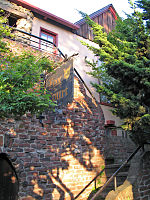Berkeley station (Atchison, Topeka and Santa Fe Railway)

Berkeley station was the name of an Atchison, Topeka and Santa Fe Railway (ATSF) railroad station in Berkeley, California from 1904 to the 1950s. It is located on University Avenue between Acton and Chestnut Streets. The station building is today occupied by The Berkeley School. The station opened in May 1904 as the ATSF was extended from its previous terminus in Richmond to a new end of the line in Oakland over the former California and Nevada Railroad. After passenger operations ceased in the 1950s, the station was used as a bus depot until those services were discontinued the following decade. The city of Berkeley acquired the railroad's right of way through city limits in 1978, but the Berkeley depot was retained by ATSF. The station building was then converted to a restaurant, and functioned in that capacity until 2000. In 2001, it was purchased by the Berkeley Montessori School and redeveloped into a private school. That same year, the building was designated a City of Berkeley Landmark. While the adjacent railbed was removed soon after the city's purchase, the replacement linear park and rail trail did not open until 2013.
Excerpt from the Wikipedia article Berkeley station (Atchison, Topeka and Santa Fe Railway) (License: CC BY-SA 3.0, Authors, Images).Berkeley station (Atchison, Topeka and Santa Fe Railway)
University Avenue, Berkeley
Geographical coordinates (GPS) Address Website Nearby Places Show on map
Geographical coordinates (GPS)
| Latitude | Longitude |
|---|---|
| N 37.869705555556 ° | E -122.28644722222 ° |
Address
The Berkeley School
University Avenue 1310
94702 Berkeley
California, United States
Open on Google Maps






